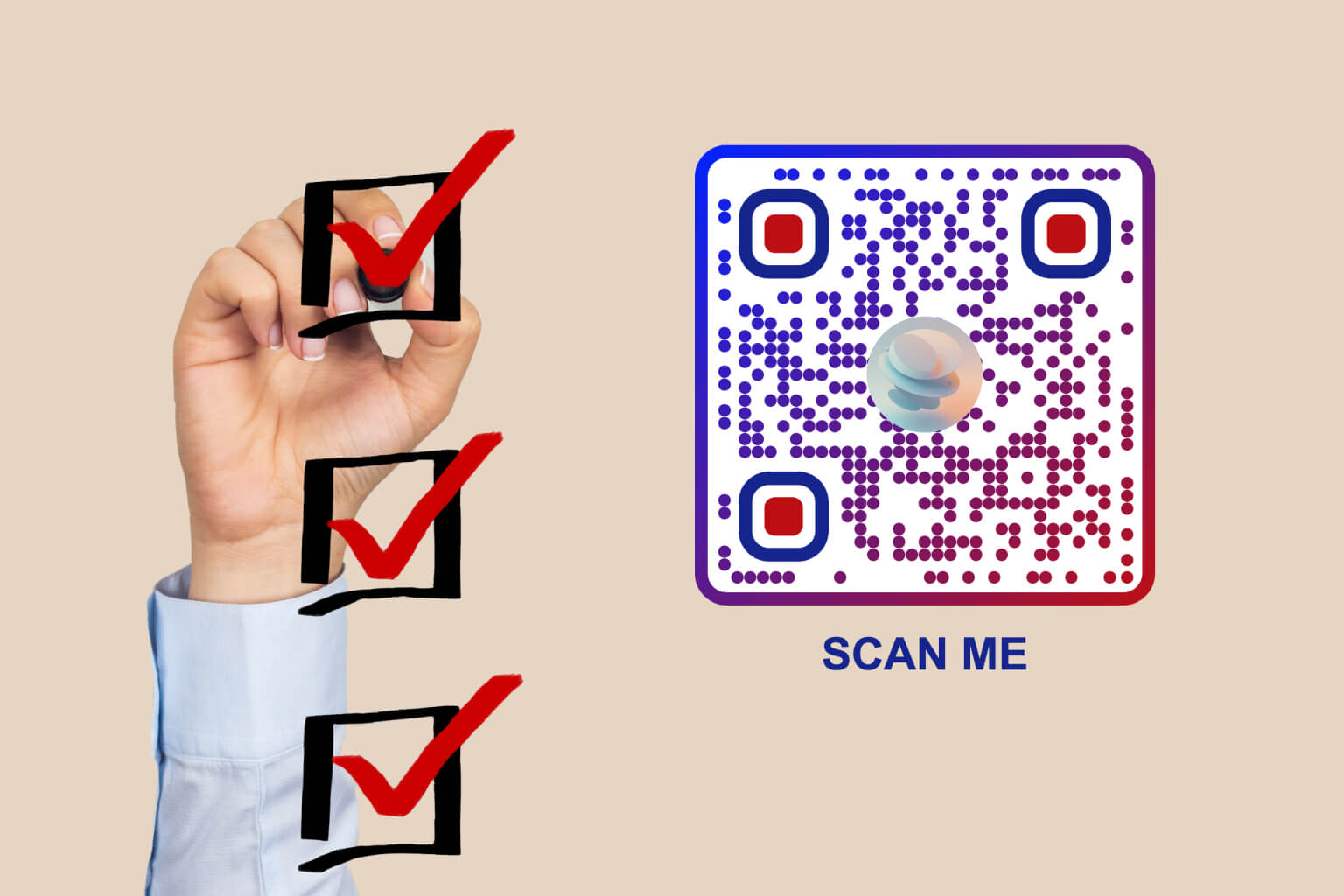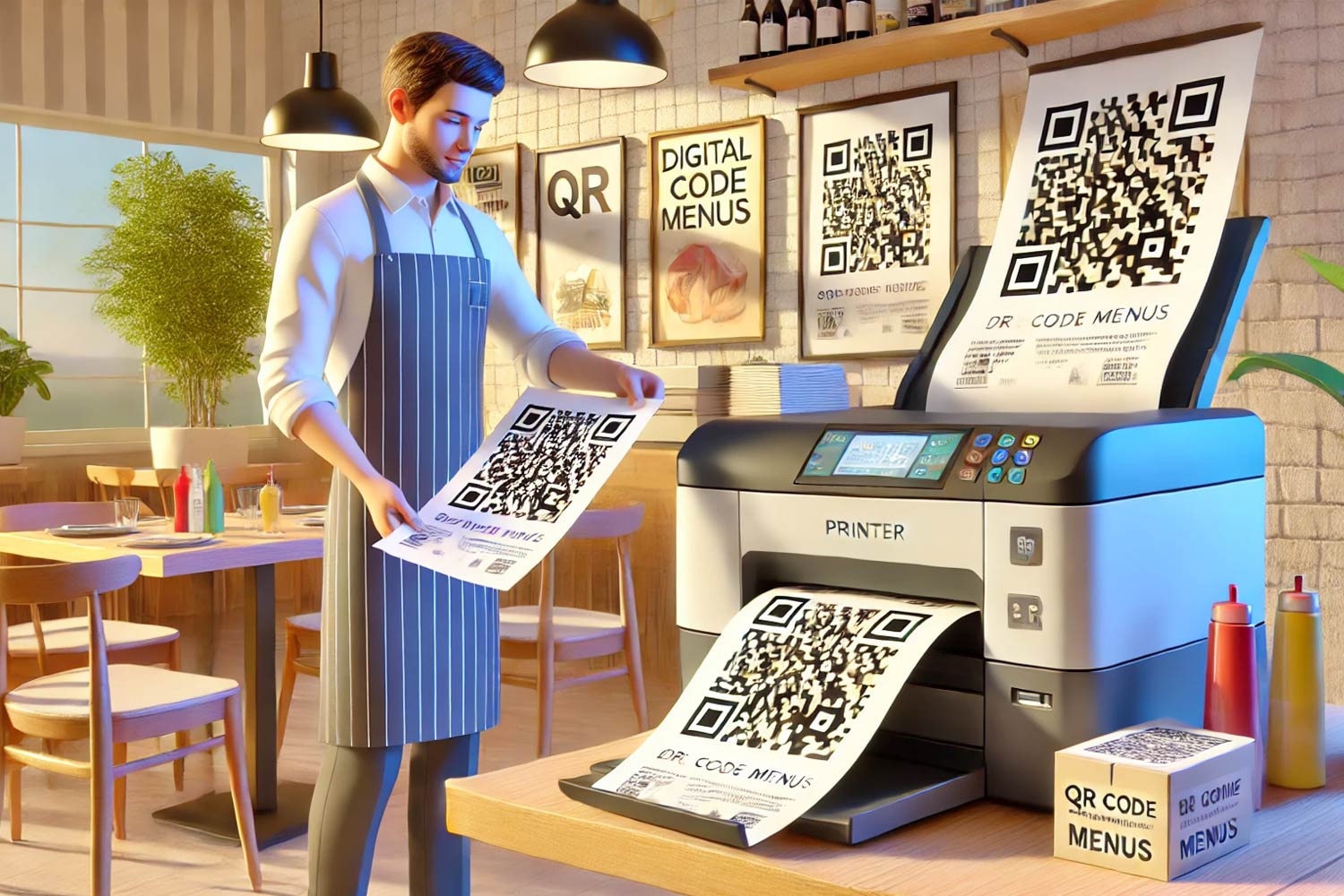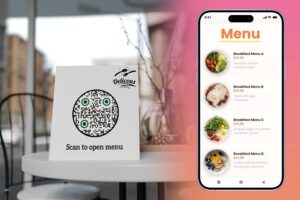QR codes are everywhere – from menus to business cards. But not all QR codes are easy to scan or trustworthy. Here’s how to design QR codes that are clear, functional, and user-friendly:
- High Contrast & Quiet Zone: Ensure strong contrast between the code and the background. Leave a blank space (quiet zone) around the code for better scanning.
- Proper Size: Use the 10:1 rule – QR code size should be at least 1/10th of the scanning distance. For example, a code scanned from 20 inches away should be at least 2 inches square.
- Add Branding: Include logos and brand colors for recognition, but keep the design simple to avoid scanning issues.
- Strategic Placement: Place QR codes where they’re easy to see and scan, like at eye level or on flat surfaces.
- Clear Instructions: Add a call-to-action like “Scan to Order” or “Get 20% Off” so users know what to expect.
- Test & Secure: Test on multiple devices and apps. Use HTTPS links and dynamic QR codes for flexibility and security.
Tips for Creating QR Codes and Bar Codes
Visual clarity and branding
The way your QR code looks plays a huge role in how easily users can scan it and how much they trust it. A well-designed QR code should strike a balance between technical functionality and your brand’s visual identity. This means ensuring it works flawlessly while reflecting your brand’s professionalism. To achieve this, focus on contrast, image quality, and thoughtful branding elements.
Ensure high contrast and quiet zone
For a QR code to scan reliably, there needs to be strong contrast between the code and its background. The classic black-on-white design works best for most devices. If you’re using brand colors, make sure there’s at least a 55% contrast between the foreground and background to keep the code easy to read.
Another critical element is the quiet zone, the blank space around the QR code. This area helps scanners differentiate the code from other design elements. As a rule of thumb, the quiet zone should be at least four times the width of one module (the small squares in the QR code). For example, if a module is 4 mm wide, the quiet zone should extend at least 16 mm on all sides. Skipping this step could lead to scanning issues.
Use high-resolution images
After optimizing contrast, focus on image quality. A pixelated or blurry QR code can frustrate users and might not scan properly, especially on printed materials like business cards or posters. Always create your QR codes in high resolution. Instead of upscaling low-quality images, start with a high-resolution file. For printed materials, vector formats are ideal because they keep edges sharp no matter the size. For digital use, ensure the image looks crisp on both standard and high-density screens.
Before mass production, test your printed QR codes to confirm they’re as clear in print as they are on-screen.
Add logos and brand colors
 Incorporating your logo and brand colors into a QR code can make it more recognizable and trustworthy. In fact, custom QR codes can increase engagement by up to 18%. When adding a logo, simplicity is key. Avoid complicated designs or tiny text that could become unreadable when scaled down. Square or circular logos work best, and they should take up no more than 25–30% of the QR code’s total area to ensure it remains scannable.
Incorporating your logo and brand colors into a QR code can make it more recognizable and trustworthy. In fact, custom QR codes can increase engagement by up to 18%. When adding a logo, simplicity is key. Avoid complicated designs or tiny text that could become unreadable when scaled down. Square or circular logos work best, and they should take up no more than 25–30% of the QR code’s total area to ensure it remains scannable.
Tools like Pageloot’s QR code generator with logo handle the technical details, including error correction, so your branded codes stay functional. Adding your brand’s color palette can also make a big impact – research shows that color increases brand recognition by 80%. However, always prioritize functionality by testing the QR code on different devices and apps to ensure it scans reliably.
Many major brands have successfully used custom QR codes in their marketing campaigns, proving that you can enhance their visual appeal without sacrificing usability. These design elements set the stage for effective QR code placement and user engagement, which will be explored further in the next sections.
Placement, Size, and Accessibility
When it comes to creating user-friendly QR codes, placement, size, and accessibility are just as important as design clarity and branding. Ensuring your QR code is easy to notice and scan can make or break its effectiveness.
Best Placement for User Interaction
For maximum visibility, place QR codes in areas that are naturally easy to spot and unobstructed. Eye-level placement is ideal, especially for posters in crowded spaces, as it prevents users from awkwardly bending or stretching to scan. For instance, in restaurants, QR codes on menus or table tents allow diners to scan comfortably while seated. Similarly, codes on product packaging in stores let shoppers quickly access reviews or demo videos while browsing.
Avoid placing QR codes on curved, reflective, or textured surfaces, as these can distort the image and make scanning difficult. Flat surfaces work best – for example, laminated table tents or menu boards provide excellent scanning conditions. In office environments, consider placing QR codes near high-traffic areas like coffee machines or light switches to ensure visibility without disrupting daily routines.
If you’re using QR codes on billboards, ensure they’re placed in locations where scanning is both safe and practical for users. Once the placement is sorted, focus on selecting the right size for reliable scanning.
Recommended Size for Scanning
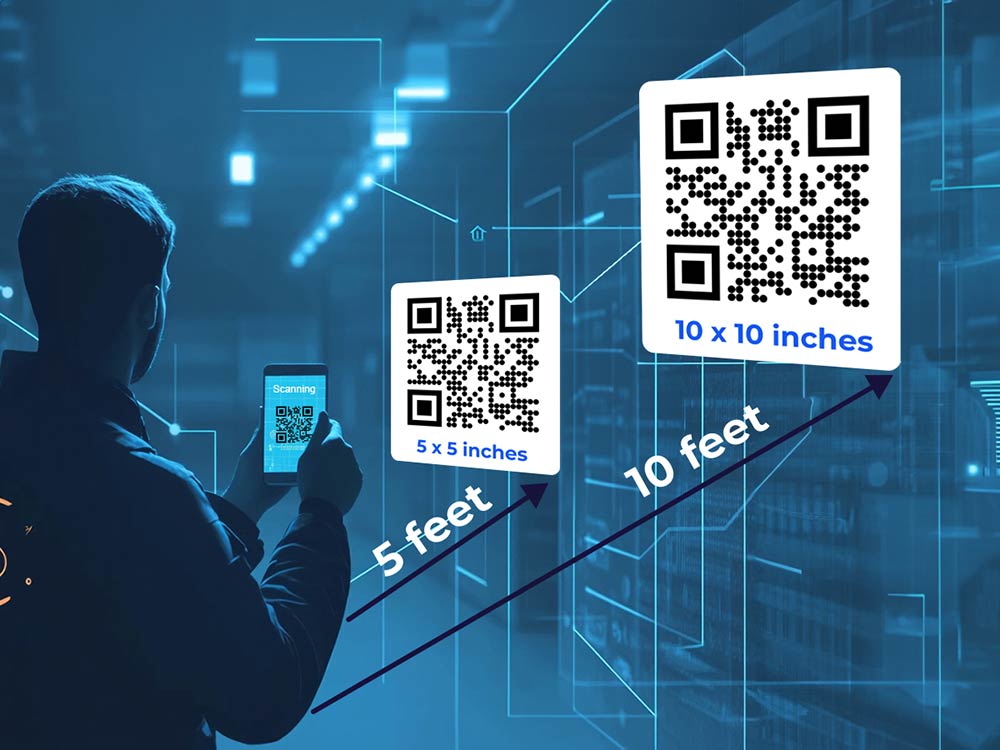 A good rule of thumb is the 10:1 distance-to-size ratio: the QR code’s side length should be at least one-tenth of the expected scanning distance. For example, if someone is likely to scan from 20 inches away, the QR code should be at least 2 inches square.
A good rule of thumb is the 10:1 distance-to-size ratio: the QR code’s side length should be at least one-tenth of the expected scanning distance. For example, if someone is likely to scan from 20 inches away, the QR code should be at least 2 inches square.
The smallest recommended size for QR codes is 0.8 inches by 0.8 inches (2 cm x 2 cm), suitable for close-range uses like business cards. However, larger sizes are generally more practical for most applications.
| QR Code Use Case | Scanning Distance | Recommended QR Code Size |
|---|---|---|
| Product packaging, business cards | 4-6 inches | 0.4-0.6 inches |
| Magazines, flyers, catalogs | 16-28 inches | 1.6-2.8 inches |
| Posters, product displays | 3-8 feet | 4-10 inches |
| Billboards | 25-50 feet | 30-60 inches |
For digital displays, aim for a resolution of at least 240 x 240 pixels at 72 DPI to ensure clarity across various screens. For printed materials, use vector formats like SVG or EPS to prevent pixelation when resizing.
Always test your QR codes. Print them in different sizes and test scanning from the expected distance on various smartphones. Tools like Pageloot’s QR size guide can provide more detailed recommendations for specific use cases.
Accessible and User-Friendly Design
Accessibility ensures that your QR codes can reach the widest possible audience. With over 315 million people worldwide registered as blind or visually impaired – and 9 out of 10 people with sight loss struggling to access product information – designing with accessibility in mind is crucial.
High contrast is essential, not just for clarity but also to support users with visual impairments. Even when incorporating brand colors, ensure there’s a strong contrast between the QR code and its background. Black on white remains a reliable choice, especially for older smartphones or users with limited vision.
Larger QR codes can also make scanning easier for those with vision challenges. Adding Braille labels near QR codes with simple instructions or descriptions can further enhance accessibility for users with severe visual impairments. Additionally, ensure the content linked by the QR code is accessible – this means including features like audio descriptions, screen reader compatibility, and clear navigation.
Real-world examples show how accessibility can enhance user experience. Kellogg’s, for example, introduced packaging in the UK with QR codes that provide audio descriptions of cereal information for people with partial sight or blindness. Similarly, the National Museum of Scotland added audio QR codes to exhibits, enabling visitors to listen to detailed readings about displayed objects.
Context, Instructions, and Call-to-Action
A QR code’s visual appeal and functionality are just the starting points. To truly engage users, it’s essential to provide context and clear instructions. Without these, even the best-designed QR code might leave users confused. Adding a clear purpose and a strong call-to-action (CTA) can turn passive onlookers into active participants, driving meaningful engagement.
Include a Clear Call-to-Action
A well-crafted call-to-action is key to turning curiosity into action. Without it, users might hesitate, unsure of what lies beyond the scan. The trick is to be specific and concise. For example, phrases like “Scan to see our menu” or “Scan for 20% off” immediately convey the benefit of scanning. Research shows that short CTAs – ideally four words or fewer – can improve engagement by up to 80%. Using direct verbs like “shop,” “get,” or “download” makes the desired action clear and compelling.
For specific use cases, tailor the CTA to fit the context. A restaurant’s QR code might feature a simple “Scan to order,” while a business card could say “Scan to connect.” These straightforward messages ensure users know exactly what they’ll gain, boosting the likelihood of interaction.
Communicate the Value Clearly
People are more likely to scan a QR code when the benefit is obvious. Instead of vague phrases like “Scan for more information,” opt for something more precise, such as “Scan for exclusive discount” or “Get your free guide.” For instance, L’Oreal Paris used QR codes to offer virtual makeup try-ons, clearly showcasing the value of the experience. Similarly, Korea’s Emart created urgency with its “Sunny Sale” campaign, where QR codes worked only during lunchtime (12 PM to 1 PM), making the benefit and timing crystal clear.
The messaging should match the content it leads to. For video content, try something like “Watch exclusive behind-the-scenes.” If offering free Wi‑Fi, a simple “Free Wi‑Fi” message is highly effective. Tailoring your message to the audience is equally important. A QR code at a construction site might say “View safety protocols,” while one in a museum could invite users to “Hear the story behind this artwork”. Clear, benefit-driven messaging ensures users understand the value immediately.
Reassure Users About Security
Security concerns can make users hesitant to scan QR codes, especially in contexts involving sensitive data like healthcare or payments. Addressing these concerns upfront helps build trust. For example, in healthcare settings, emphasizing that links are secured with HTTPS encryption can reassure users. For payment-related QR codes, highlighting that transactions are processed through trusted platforms can ease doubts.
Dynamic QR codes offer an additional layer of security by allowing updates or deactivation if needed. Platforms like Pageloot enable you to create QR codes with these features, ensuring flexibility and safety. Adding small reassurances, such as “Secure link” or “Safe to scan,” near the code can also help. Including your logo further legitimizes the interaction. For instance, McDonald’s integrates QR codes directly into its official packaging and app, giving users confidence in the code’s authenticity.
sbb-itb-74874c9
Functionality, Testing, and Analytics
A QR code needs to work seamlessly across all devices. While design is important, ensuring that the code functions properly is critical for keeping users engaged. On top of that, tracking its performance through analytics can turn a simple QR code into a powerful tool for understanding user behavior and improving campaigns.
Test for Universal Functionality
Before rolling out a QR code campaign, it’s essential to test it across a variety of devices and scenarios. Smartphones, tablets, and different scanning apps can behave differently, meaning a code that works on one device might fail on another. Test your QR code on multiple smartphone models – both Android and iOS – to confirm it works smoothly across platforms.
Additionally, try scanning the code using both built-in camera apps and third-party scanning apps to uncover any compatibility issues. Pay attention to loading times and confirm that users are directed to the correct destination every time they scan.
For more advanced campaigns, you can simulate real-world conditions to ensure the code remains reliable in diverse environments. This level of testing can help avoid unexpected issues once the campaign goes live.
Dynamic QR codes are another way to maintain flexibility and adapt to changing needs.
Use Dynamic QR Codes for Flexibility
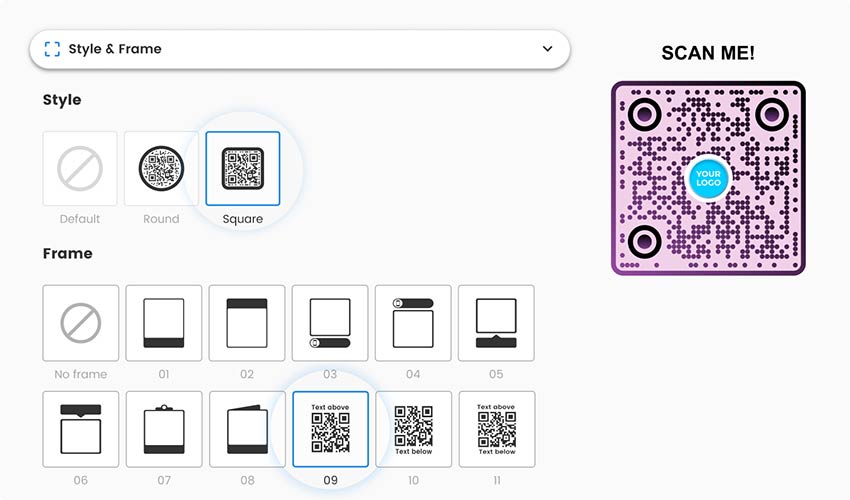 Dynamic QR codes allow you to update the destination URL without needing to reprint the code, saving both time and money. This flexibility is especially useful for campaigns that require frequent updates.
Dynamic QR codes allow you to update the destination URL without needing to reprint the code, saving both time and money. This flexibility is especially useful for campaigns that require frequent updates.
Beyond their adaptability, dynamic QR codes come with several other benefits. They are usually smaller and easier to scan because they use shorter URLs. They also offer added security features like password protection and access controls, which are ideal for sensitive applications. Additionally, they enable smart redirection based on factors like the user’s location, the time of day, or the type of device being used.
For example, Marriott Aruba saved $150,000 by switching to dynamic QR code menus. This change not only eliminated printing costs but also allowed them to update menus throughout the day, showing breakfast, lunch, or dinner options as needed.
If you use Pageloot’s platform to create a QR code, you’ll have access to these dynamic features, along with customization options that can increase scan rates by up to 80%. While the cost of dynamic QR codes starts at around $15 for three codes, the flexibility and insights they provide often make them a worthwhile investment.
Once your QR code is set up, the next step is to monitor its performance using analytics.
Use Analytics for Insights
Analytics can transform QR codes into valuable data tools. With QR code scans projected to hit 26.95 million in 2024 – a fourfold increase – understanding user behavior through analytics is more important than ever.
QR code analytics go far beyond counting scans. They can reveal when and where scans happen, the types of devices users prefer, and how long people engage with your content. This data helps identify trends that can shape future marketing strategies.
For instance, a skincare brand discovered through analytics that engagement was higher in humid regions. This insight led them to launch moisture-focused product lines tailored to those areas.
Key metrics to track include:
- Sessions: Total visits generated by QR scans.
- Engaged Sessions: Interactions lasting over 10 seconds.
- Engagement Rate: The percentage of sessions with meaningful interaction.
- Average Engagement Time: How long users stay engaged per session.
Pageloot’s analytics dashboard makes it easy to track these metrics in real time, helping businesses refine their campaigns. Whether you’re using QR codes for restaurant menus or as part of a marketing agency campaign, having access to detailed performance data allows for smarter, data-driven decisions that maximize your return on investment.
Combining these analytics with strong design and thorough testing ensures continuous improvement and better results over time.
Security and Trust
After discussing accessibility and functionality, let’s shift to another key aspect of QR codes: security. Secure QR codes not only protect business and customer data but also build trust. With over 2.2 billion people expected to use QR code payments by 2025 – accounting for 29% of all mobile phone users worldwide – security has become more critical than ever. Alarmingly, about 60% of emails containing QR codes are spam, underscoring the need for robust security measures. This focus on safety ties directly to earlier discussions about dynamic features and functionality.
Use Trusted Links and Domains
Always use HTTPS links to secure connections. That little padlock icon in the browser reassures users that their data is safe.
Stick to branded domains that are instantly recognizable. A familiar domain name builds trust and encourages users to follow through with the action. If you’re using a subdomain, make sure it aligns closely with your main brand to avoid confusion.
For businesses utilizing Pageloot’s QR code generator, the platform ensures secure, branded links by default. This is particularly crucial for e-commerce platforms, where customers need to feel confident when entering sensitive payment information.
Prevent Tampering and Misuse
Tampered QR codes can harm your brand and put customers at risk. Public incidents have shown how altered QR codes can redirect users to phishing sites.
"The goal of these scams? To steal personal data and financial information from the consumer."
– Erin Donnelly, Copywriter, Global Payments Integrated
To combat this, regularly inspect QR codes for signs of tampering, such as misalignments or sticker overlays. Consistent visual branding also helps users identify authentic codes.
Customizing QR codes with your logo, brand colors, and unique designs makes them harder to replicate. A distinct look not only reinforces trust but also makes fraudulent codes easier to spot.
For high-risk areas like restaurant tables or public spaces, consider adding verification features. For example, display a partial URL or confirmation code next to the QR code so users can double-check its legitimacy.
Secure QR Code Management
Managing QR codes effectively is key to enterprise-level security. Platforms like Pageloot offer advanced options, such as password protection, access controls, and the ability to disable compromised codes instantly – no need to reprint materials. These proactive measures make tampering less likely.
Enable multi-factor authentication for managing QR codes tied to sensitive data or payments. Regular updates and continuous monitoring can help catch vulnerabilities before they become security breaches. Dynamic QR codes add another layer of protection by allowing remote deactivation if any risks are detected.
Industries handling sensitive information, such as healthcare or education, can benefit from risk-based authentication. This approach adjusts security requirements depending on the type of data being accessed.
To accommodate users wary of QR codes, always provide alternative access points. Include traditional options like website URLs or phone numbers alongside QR codes to ensure everyone can access your content safely.
If a security issue arises, having a rapid response system in place is crucial. Quickly addressing problems, notifying affected customers, and mitigating further risks demonstrates your commitment to safety and helps maintain trust. These proactive steps show customers that their security is your priority.
Conclusion
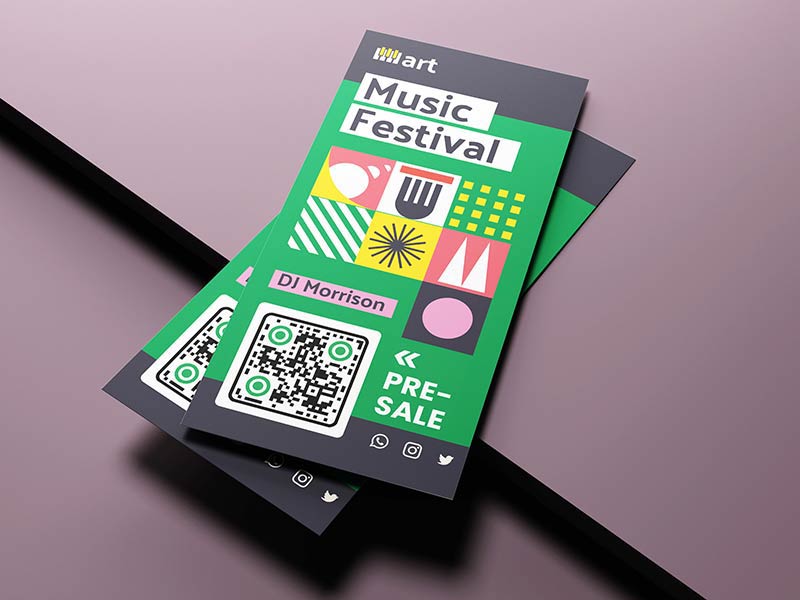 Creating effective QR codes isn’t just about slapping together a black-and-white pattern – it’s about building a seamless link between the physical world and digital interactions. To make QR codes work, focus on the essentials: clear visuals with strong contrast and branding, strategic placement and sizing for accessibility, compelling calls-to-action for user engagement, reliable functionality across devices, and robust security to protect users and earn trust.
Creating effective QR codes isn’t just about slapping together a black-and-white pattern – it’s about building a seamless link between the physical world and digital interactions. To make QR codes work, focus on the essentials: clear visuals with strong contrast and branding, strategic placement and sizing for accessibility, compelling calls-to-action for user engagement, reliable functionality across devices, and robust security to protect users and earn trust.
In 2024, an estimated 89.5 million Americans were projected to scan QR codes using their smartphones. The marketing and advertising industries alone reported a staggering 323% jump in QR code scans in 2023. However, with 71% of people unable to differentiate between fake and genuine QR codes, implementing secure solutions has become more critical than ever. These numbers underline the importance of well-integrated, secure QR code strategies.
Platforms like Pageloot offer all-in-one solutions, from advanced customization to real-time analytics. Whether you’re a marketing agency managing multiple campaigns or a restaurant updating menus, dynamic QR codes allow you to adapt quickly without the hassle of reprinting materials.
The benefits extend beyond convenience. For instance, companies can reduce labor and IT support costs by 30-50% using QR code authentication, especially when compared to the $5.2 million businesses spend annually on password management. When design and functionality align, businesses not only improve user engagement but also see tangible cost savings.
Thorough testing is non-negotiable – your QR code’s functionality must match its design. By applying this checklist, you can enhance trust, boost engagement, and deliver measurable results through QR codes that work seamlessly for both users and businesses.
FAQs
How can I customize my QR code with brand colors and logos without affecting its scannability?
To keep your QR code easy to scan while showcasing your brand’s colors and logo, focus on maintaining strong contrast. A good rule of thumb: use dark colors for the QR code itself and place it on a lighter background. Stay away from overly complex designs or logos that interfere with the essential data points of the code. Logos should be simple, placed in the center, and sized just right to avoid disrupting functionality.
After customizing your QR code, always test it to ensure it works seamlessly across various devices and scanning apps. Tools like Pageloot can help you design branded QR codes that look great and work perfectly.
What are the best practices for placing QR codes in public spaces to increase user engagement?
When aiming to boost user interaction, it’s crucial to position QR codes in spots that grab attention. Choose areas that are well-lit, easy to spot, and conveniently within reach – think eye level or a spot where someone can easily extend their arm. Opt for durable, matte surfaces to prevent glare, which can interfere with scanning.
To ensure smooth recognition by smartphone cameras, design the QR code with high-contrast colors and leave enough white space around it. Before rolling it out, test the placement to confirm it works seamlessly and make tweaks as needed. Smart positioning like this can make a noticeable difference in how often people engage and scan.
What makes dynamic QR codes more secure and versatile than static QR codes?
Dynamic QR codes step up security by offering features like access controls and real-time updates. These capabilities help reduce risks like credential theft or misuse. Unlike static QR codes, which lock in their data permanently, dynamic codes let you update the linked content whenever needed – no need to create a brand-new code. This makes them perfect for changing marketing campaigns, secure transactions, or any scenario where information needs to be updated often.
Another big advantage? Advanced analytics. Dynamic QR codes can track user interactions, giving businesses valuable insights to guide their decisions. With their flexibility and powerful features, they’re a smart pick for businesses aiming to get the most out of their QR code strategies.

